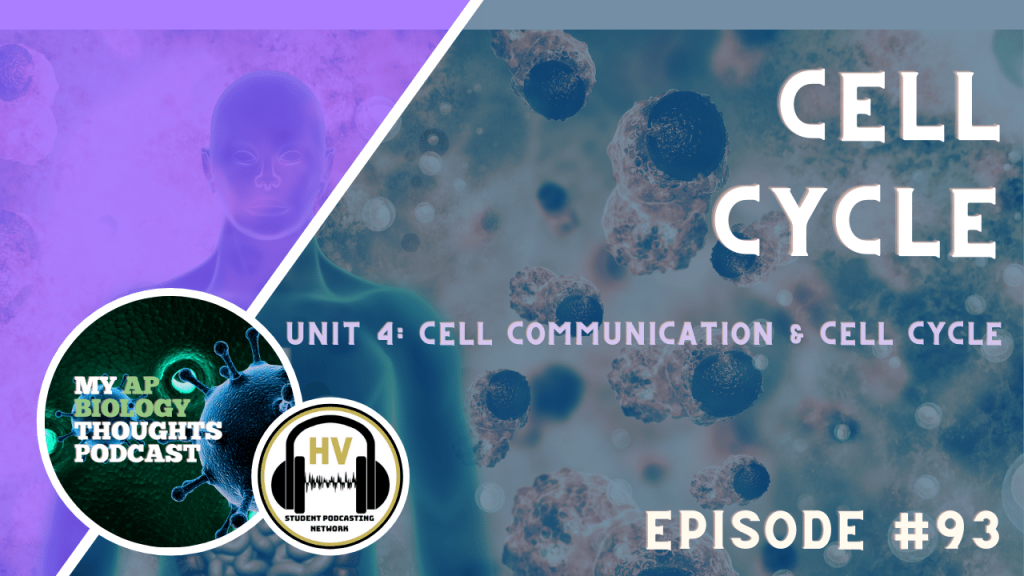Cell Cycle

My AP Biology Thoughts
Unit 4 Cell Communication and Cell Cycle
Welcome to My AP Biology Thoughts podcast, my name is Chloe McGregor and I am your host for episode #93 called Unit 4 Cell Communication and Cell Cycle: The Cell Cycle. Today we will be discussing the basics of the cell cycle including how it works and what products are made.
Segment 1: Introduction to the Cell Cycle
- The cell cycle is split up into 2 different parts, each with their own purpose. The first part of the cell cycle is called interphase. The cell spends a majority of its time in this phase. Interphase itself is made up of 3 different stages. These stages are the G1, S, and G2 phase. The first step in interphase is G1. During this step, the cell spends its time growing in size and gaining a sufficient amount of resources. With this abundance of resources, the cell is able to replicate its DNA and intracellular components during the S phase. The third step is G2 where the cell continues its growth and will stop its progression to the mitotic phase if there are any issues or damaged DNA. The second part of the cell cycle is the mitotic phase which has 2 parts. The first part is mitosis. Mitosis consists of four steps: Prophase, metaphase, anaphase, and telophase. More details about these steps will be discussed later in the episode, but generally they work together in order to separate the replicated DNA. The second part of the mitotic phase is cytokinesis where the cell actually splits into 2 new identical daughter cells. Overall, each step in the cell cycle is important to grow the cell and its resources in order to produce 2 identical daughter cells, each with the same copies of DNA. Another important part of the cell cycle is the G0 phase. Although this isn’t the generic path of cell replication , a cell may enter the G0 phase if there is a non sufficient amount of resources and nutrients available to proceed to healthy replication. Cells may also enter G0 if they are adult cells that are not necessarily looking to replicate. For example, a lot of cells in your brain and nervous system stop replicating once you reach adulthood, so an injury in these areas could be extremely difficult, or impossible, to heal.
Segment 2: More About the Cell Cycle
- To go more in depth, let’s talk about the different steps in mitosis. Once again, these steps are prophase, metaphase, anaphase, and telophase. The goal of mitosis is to separate the replicated DNA on opposite sides of the cell, with both sides having identical copies of the DNA. Prophase begins once G2 is finished and the cell has grown enough. In prophase, the DNA condenses, and the replicated chromosomes have a more visible shape to them. The replicated chromosomes are called sister chromatids and are linked together at a point called the centromere. The next step, metaphase, is when the replicated chromosomes line up in the center of the cell in a line. Anaphase is next, and this is where the spindle fibers on each side of the cell attach to the centromere region on each sister chromatid. Then, the fibers pull the sister chromatids apart, leaving opposite sides of the cell with identical genetic material. Telophase is the last stage of mitosis where each side of the cell begins to form a nuclear envelope around the new genetic material. The chromosomes also unravel back into chromatin. Once mitosis is complete, the cell membrane scrunches in the middle of the cell causing it to physically separate into two identical daughter cells. This step is called cytokinesis. Another important point to touch on is the checkpoints that occur during the cell cycle. Although there is a separate episode on cell cycle regulation, it is important to understand that the cell reaches checkpoints throughout the entire cell cycle which ensure that it is healthy, and that the DNA is replicating correctly. There are 3 checkpoints. These are near the end of G1, between G2 and the M phase, and one during metaphase. These checkpoints are extremely important to ensure that the products of the cell cycle are two completely identical and healthy daughter cells.
Segment 3: Connection to the Course
- An important connection to the course is the idea of mutations, and how they occur during the cell cycle. A mutation is a change in the structure of a gene caused by a mistake or alteration in the base units of the DNA. Because mutations involve DNA, they can occur during S phase or mitosis when the DNA is being replicated and split into two new cells. Mutations can be silent, beneficial, or detrimental to an organism which plays a big role in evolution. As random mutations occur during the cell cycle, organisms can evolve and natural selection can occur causing only the most fit organism to survive and reproduce. Overall, the cell cycle is extremely important to the growth and survival of organisms around the world, and includes many intricate steps and phases to make sure it is done correctly and efficiently.
Thank you for listening to this episode of My AP Biology Thoughts. For more student-ran podcasts and digital content, make sure that you visit www.hvspn.com.
Music Credits:
- “Ice Flow” Kevin MacLeod (incompetech.com)
- Licensed under Creative Commons: By Attribution 4.0 License
- http://creativecommons.org/licenses/by/4.0/
Subscribe to our Podcast
Connect with us on Social Media
Twitter @thehvspn
Welcome to My AP Biology Thoughts podcast, this is episode #93 called Unit 4 Cell Communication and Cell Cycle: The Cell Cycle.

